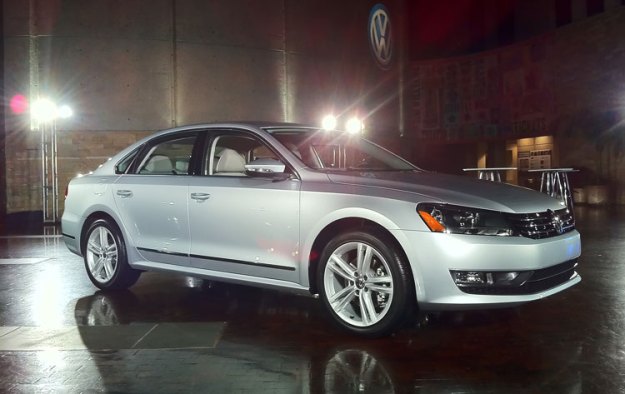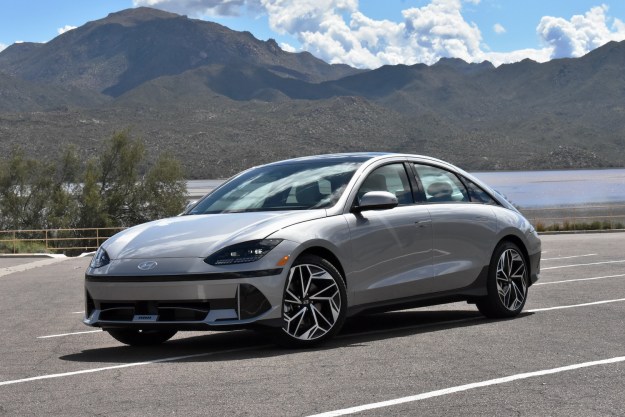
What do pizza, hot dogs and burritos have in common with Volkswagen’s 2012 Passat? They’re foreign products that Americans have — depending on your perspective — either perfected or perverted.
For 2012, Volkswagen gave up on pushing the German-built Passat on American roads, totally re-engineering it for the lucrative midsize sedan market here. While Volkswagen purists may scoff at the idea of a Passat tailored to American tastes with little in common with its Euro-born cousin, Volkswagen’s spiritually red white and blue Passat has a number of surprising tweaks in its favor.
So how do you Americanize a German sedan? Don’t think too far outside the stereotypes, G.I. Joe. By stretching out the Passat four inches, overhauling the exterior and relocating its production to Chattanooga, Tennessee, Volkswagen made the Americanized Passat bigger, cheaper, and according to its designers, more masculine.
That last point will prove to be a matter of debate. While German designers (they still handle that abroad) gestured wildly to horizontal lines in the front facia, a raked out hood and steeper angles, we have a hard time calling the Passat menacing, and it’s certainly nowhere near Detroit’s downright fiendish Charger or Camaro.

Quite unlike visiting a hot dog factory or the kitchen in a Tex Mex restaurant, the process behind making the new Passat is not an ugly secret so much as a point of pride for Volkswagen. The company poured $1 billion (that’s with a B) to turn the sleepy riverside town of Chattanooga, Tennessee into a little slice of Wolfsburg in the heart of pickup truck country. Think computer-guided robot welding, lasers that check tolerances within 1mm, and music that speeds up as problems persist on an assembly line to get workers scrambling.
Despite this birthplace in the sweltering heartland of America, on the inside, the Passat retains the distinctly German feel of its Volkswagen brothers and sisters. Solid soft-touch plastics greet the hands on knobs and handles, leather seats feel plush — but supportive — and even the dash has a solid feel to it that defies what you would expect from a car starting at $19,995. Don’t worry: It’s got cup holder’s too, and they handled our how-can-you-even-drink-that-much-coffee sized cappuccinos just fine. Leg room? With an extra three inches in back versus lack year’s model (a common source of complaint, according to VW), not a problem.
VeeDub offers the Passat with three different engines for three different American sensibilities: cheap, fast and efficient. A 2.5-liter five cylinder hits an adequate but yawnworthy 170HP, a 3.6-liter V6 roars all the way to 277HP, and a 2.0-liter, four-cylinder TDI that hits, well, who cares, it gets 43mpg on the highway. Opting for the base TDI package will tack an extra $6,000 onto the starting price, but besides the bulletproof TDI engine, it also scores you all sorts of goodies that help justify the upgrade, like 17-inch alloy wheels and heated leather seating.

In the driver’s seat, the Passat feels pliant but composed — cruising over broken pavement without complaint at 70mph but still ready to dive into the next twist without feeling like its rolling around on cotton balls. Power from the frugal TDI is surprisingly adequate and the V6 gets downright vicious in Sport mode, laying down rubber and revving high into its smooth powerband. It feels significantly more mild-mannered without — highway passing at wide open throttle will still raise the hair on your arms, but VW’s six-speed DSG automatic refuses to let you get too frisky without a wink and a yank back on the shifter.
The electronic navigation and entertainment system offers standard features like Sirius XM radio and DVD playback but doesn’t really aspire to any original levels of integration, and seems to have trouble doing some of the easy stuff, too. Using the iPod cable in the glovebox puts your device on a painfully short leash, the jack never seemed to want to stay in very well, and we never actually got the system to play from it after recognizing it. VW also strangely passed on offering a standard USB connector, which would open the system up both to thumb drives and charging for non-Apple phones. MyFord Touch, with all its flaws, is still miles ahead and closer to offering the type of interface the iPad generation can relate to.

With a base price a full $7,000 below last year’s Passat, Volkswagen clearly intends to play hardball with other midsize sedans like the Accord and Camry. The style and reputation of these perennially popular imports may give them an edge, but the option of a TDI engine and German-caliber build quality make the Passat uniquely alluring. For $25,995, the TDI Passat offers hybrid-like fuel economy from well-mannered powerplant that has longevity in its bloodline. You can’t even start a Ford Fusion Hybrid in that price range, much less get one with leather heated seats like the TDI Passat has standard.
Will Americans embrace the new Passat as their own, or turn up their noses at a VW devoid of its German quirkiness? We’ll know for sure when the first Chattanooga-born Passats go on sale in late September, but judging by the number of booming pizza joints, Mexican kitchens and hot dog stands in any given city across the country, VW’s odds aren’t bad.
Editors' Recommendations
- Volkswagen ID.7: price, release date, range, and more
- Volkswagen ID.4 vs Tesla Model Y
- Mercedes-AMG EQE SUV first drive review: a better electric SUV
- 2024 Mercedes-AMG S63 E Performance first drive review: high-performance plug-in
- 2024 Audi Q8 e-tron first drive review: 300-mile luxury EV cruiser


